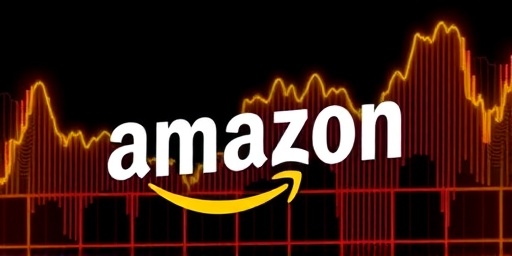In a vibrant start to November, the S&P 500 and Nasdaq composite indices surged, propelled by renewed investor enthusiasm for artificial intelligence initiatives across major corporations. The S&P 500 climbed 1.2% to close at 5,850 points, while the Nasdaq soared 1.5% to 18,400, marking their strongest opening week of the quarter. At the forefront of this rally was Amazon, whose shares rocketed to an all-time high of $195 per share, up 3.1% in a single session, underscoring the pivotal role of AI investment in driving stock market momentum.
Amazon’s AI Push Ignites Record Share Performance
Amazon’s ascent wasn’t just a blip on the radar; it was a testament to the company’s aggressive pivot toward AI integration. The e-commerce giant’s cloud computing arm, Amazon Web Services (AWS), reported a 15% year-over-year revenue increase in its latest quarterly earnings, largely attributed to surging demand for AI-powered services. Investors are betting big on AWS’s Bedrock platform, which enables businesses to build and scale generative AI applications with minimal friction.
“Amazon is positioning itself as the backbone of the AI revolution,” said Sarah Thompson, a senior analyst at Morningstar. “Their investments in custom silicon chips and machine learning infrastructure are paying off, drawing in clients from startups to Fortune 500 companies.” Thompson’s assessment aligns with recent data showing AWS capturing 31% of the global cloud market, a figure bolstered by AI workloads that now account for over 20% of its growth.
The stock market’s reaction was immediate. Amazon’s shares not only hit a record but also pushed its market capitalization past $2 trillion for the first time since early 2022. This milestone comes amid broader AI investment fervor, with Amazon committing an additional $75 billion to data centers and AI research over the next five years. Retail investors, too, piled in, with trading volume spiking 25% above average, according to data from the New York Stock Exchange.
Beyond AWS, Amazon’s consumer divisions are weaving AI into everyday operations. From personalized shopping recommendations powered by advanced algorithms to logistics optimizations via predictive analytics, the company’s ecosystem is becoming increasingly AI-centric. This holistic approach has analysts forecasting a 12% earnings growth for Amazon in the coming fiscal year, further fueling the stock market’s bullish sentiment.
AI Investment Wave Lifts S&P 500 Broadly
The ripple effects of AI investment extended far beyond Amazon, lifting the S&P 500 to new heights. Tech-heavy components within the index, including Microsoft and Alphabet, each gained over 2%, contributing to a sector-wide boost of 1.8%. The S&P 500’s technology sector, which constitutes about 30% of the index, has been the primary driver of its 25% year-to-date gains, with AI as the undisputed catalyst.
Corporate spending on AI is projected to reach $200 billion globally by 2025, per a Gartner report, and U.S. firms are leading the charge. In the S&P 500 universe, 78% of companies now mention AI in their strategic outlooks, up from just 45% two years ago. This shift is evident in earnings calls: During the third quarter, S&P 500 firms allocated 18% of capital expenditures to AI-related projects, a 40% increase from 2022 levels.
Market data underscores the optimism. The CBOE Volatility Index (VIX), often called Wall Street’s fear gauge, dipped to 15.2, its lowest in months, signaling reduced uncertainty. Bond yields also eased, with the 10-year Treasury note falling to 4.1%, creating a favorable environment for equities. “The S&P 500’s resilience in the face of higher interest rates is largely due to AI’s productivity promise,” noted economist Dr. Elena Vasquez from the Federal Reserve Bank of New York. “It’s not hype; it’s tangible value creation.”
Smaller S&P 500 constituents aren’t being left behind. Companies like Nvidia, a key AI chip supplier, saw its stock jump 4.2%, while semiconductor peers such as AMD and Intel followed suit with gains of 2.5% and 1.8%, respectively. This broad participation highlights how AI investment is permeating the stock market, from megacaps to mid-tier players.
Nasdaq’s Tech-Fueled Surge Signals Deeper AI Momentum
Turning to the Nasdaq, the index’s outperformance—edging out the S&P 500 by a full percentage point—reflects its heavier weighting toward innovative tech firms. With over 3,000 listings dominated by AI adopters, the Nasdaq has become synonymous with the AI investment boom. The index’s top performers included AI darlings like Tesla, up 2.7% on announcements of AI-enhanced autonomous driving features, and Palantir Technologies, which rose 3.5% after securing a major government AI contract.
Quantitative metrics paint a vivid picture. Nasdaq-listed companies have increased R&D spending on AI by 35% in the past year, according to Bloomberg Intelligence. This infusion is yielding results: AI software revenues across Nasdaq firms grew 28% quarter-over-quarter, outpacing the overall stock market’s 8% earnings expansion. Venture capital flows into AI startups, many of which are Nasdaq-bound upon IPO, totaled $50 billion in the third quarter alone, per PitchBook data.
Investor sentiment surveys reinforce the trend. A recent poll by Charles Schwab found that 62% of retail investors view AI as the top opportunity in the stock market for 2024, up from 48% in June. Institutional players are equally bullish; BlackRock’s latest fund inflows into AI-themed ETFs reached $12 billion, the highest monthly figure on record. “The Nasdaq isn’t just riding the AI wave—it’s shaping it,” commented portfolio manager Raj Patel of Vanguard. “Expect more M&A activity as big tech consolidates AI talent and IP.”
However, not all sectors within the Nasdaq shared equally in the gains. Consumer discretionary stocks, including Amazon, led with a 2.1% sector rise, while more traditional areas like utilities lagged at 0.5%. This divergence emphasizes AI’s role as a growth differentiator in the stock market landscape.
Expert Views on AI’s Role in Sustaining Market Gains
Wall Street pundits are unanimous in crediting AI investment for the S&P 500 and Nasdaq’s November surge, but they caution about sustainability. “AI is the new oil for the economy, but like any commodity, its value depends on efficient extraction,” quipped Jamie Dimon, CEO of JPMorgan Chase, during a recent investor conference. Dimon’s bank has ramped up its own AI initiatives, deploying machine learning for fraud detection that saved $500 million annually.
Analysts from Goldman Sachs project that AI could add $7 trillion to global GDP by 2030, with U.S. stock market beneficiaries reaping the lion’s share. Yet, risks loom: Over 40% of executives surveyed by McKinsey worry about AI regulatory hurdles, particularly around data privacy and ethical use. In the U.S., the Federal Trade Commission is scrutinizing AI monopolies, which could temper M&A in the sector.
From a valuation standpoint, the S&P 500’s forward P/E ratio stands at 21.5, elevated but justified by AI-driven earnings growth forecasts of 15% for 2024. The Nasdaq trades at a premium of 28 times earnings, reflecting its growth tilt. “Investors should focus on companies with proven AI monetization paths, like Amazon, rather than speculative plays,” advised Lynn Chen, chief strategist at Fidelity Investments.
Global context adds nuance. While U.S. markets lead in AI investment, Europe’s lag— with only 12% of S&P 500-equivalent firms emphasizing AI—creates opportunities for cross-border deals. China’s regulatory clampdown on AI has funneled more capital toward American stocks, boosting the S&P 500 and Nasdaq further.
Outlook: AI Investment Shapes Stock Market Trajectory Ahead
Looking forward, the stock market’s trajectory hinges on upcoming catalysts. The Federal Reserve’s November meeting could signal interest rate pauses, providing tailwinds for AI-heavy indices like the S&P 500 and Nasdaq. Earnings season, kicking off in earnest this week, will test whether AI investment translates to bottom-line results. Amazon’s full-year guidance, expected to highlight $100 billion in AI-related revenues, could set the tone.
Broader implications extend to employment and innovation. AI is projected to create 97 million new jobs by 2025, per the World Economic Forum, offsetting automation displacements. For investors, diversified exposure via ETFs tracking the S&P 500 or Nasdaq remains prudent, with AI-themed funds like the Global X Robotics & Artificial Intelligence ETF up 35% year-to-date.
Challenges persist: Geopolitical tensions and supply chain bottlenecks for AI hardware could introduce volatility. Nonetheless, the consensus is optimistic. “AI investment isn’t a fad; it’s the foundation of the next industrial era,” stated NVIDIA CEO Jensen Huang in a keynote address. As November unfolds, the S&P 500 and Nasdaq’s early surge suggests the stock market is poised for continued gains, with Amazon and its AI peers leading the charge toward unprecedented heights.









